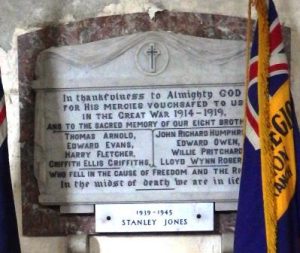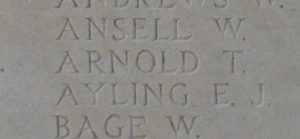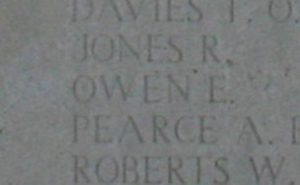Machynlleth is a market town and community in the county of Montgomeryshire, situated in the Dyfi Valley at the intersection of the A487 and the A489 roads. The town has ancient origins and was the seat of Owain Glyndŵr’s Welsh Parliament in 1404. The town lies some eight miles from the Cardigan Bay coast. While the men of Machynlleth who fell during both World Wars are commemorated on the town’s Cenotaph, which is situated in a prominent position at the junction of Heol Penrallt, Heol-Y-Doll and Maes Glas, St. Peter’s Church at Heol Penrallt, Machynlleth also has its own war memorial, which commemorates the eight members of the congregation who died in the First World War and one who died in the Second World War. There is also one war grave within the churchyard, which marks the final resting place of John Watkin Lewis, of the South Wales Borderers, who died in January 1920, aged 34. The war memorial in St. Peter’s Church takes the form of a white marble, with carved drapery on its top and sides and an incised inscription, with the sole casualty of World War Two commemorated on a small plaque which has been affixed below.

The Great War, 1914-1918
Thomas Arnold, Private, 39053, South Wales Borderers. Thomas was the son of David Arnold and Mary Arnold (nee Davies), of Pantlludw Cottages, Machynlleth. Thomas worked as a waggoner before the war. He enlisted into the Royal Welsh Fusiliers at Machynlleth, and in the summer of 1917 was drafted to France, where he was transferred to the 1st Battalion, South Wales Borderers. The battalion was attached to 3 Brigade, 1st Division and had been on the Western Front since the outbreak of the war. Thomas joined the 1st SWB at Le Clipon camp, near Coxyde, on the Channel coast, where the 1st Division had been preparing for a possible offensive. The Passchendaele offensive had, however, stalled in the Flanders mud, so the 1st Division was one of several transferred from the coast to the Ypres Salient, in an attempt to make a breakthrough. The 1st Division moved into camps near Poperinghe by 1 November and the men trained in preparation to move into the line. On 8 November the 1st SWB moved out of camp and marched to its new positions at Irish Farm, where the men spent an unpleasant night under shellfire in the trenches for the first time in months. On the following morning the battalion received orders to take up positions in readiness for an assault and formed up along a 200-yard frontage west of Valour Farm, with their objectives being Virtue Farm, Virile Farm, Vocation Farm, Box Farm and Void Farm, with a number of pillboxes at Goudberg Copse also being targeted. At dawn on 10 November 1917 the battalion launched its assault in terrible conditions. Thomas was killed at some time during the day. The 26-year-old has no known grave and is commemorated on the Tyne Cot Memorial, Belgium.

Edward Evans, Private, M2/226786, Royal Army Service Corps. Edward was the son of Edward and Hannah Evans, of 23, Pentrehedyn Street, Machynlleth. He enlisted into the Army Service Corps and was posted to the Middle East, before joining the 729th Motor Transport Company, Army Service Corps in Mesopotamia in 1916. Edward served overseas for three and a half years but took ill whilst on board ship in the Mediterranean during the voyage home. He was hospitalised in Malta where he died of influenza on 18 February 1920. The 23-year-old is buried in Pieta Military Cemetery, Malta.
Harry Fletcher. Harry cannot presently be identified.
Griffith Ellis Griffiths, Private, 77493, Royal Welsh Fusiliers. Griffith was the son of Griffith Griffiths and Gwen Griffiths (nee Whittaker), of 45, Dovey View, Machynlleth. He was a member of St. Peter’s Church and was a chorister before going to Port Talbot to find work after leaving school. Griffith enlisted into the army at Port Talbot and was drafted to France in the Spring of 1918, joining the 17th Battalion, Royal Welsh Fusiliers, which was holding the line north of Albert along Bouzincourt Ridge, attached to 115 Brigade, 38th (Welsh) Division. The Division had moved here at the end of March 1918, relieving the battered 2nd and 47th Divisions. It held this sector, again carrying out minor operations and trench raids, over the coming months, before taking part in the great offensive of 21 August 1918, and began its advance towards the Hindenburg Line. The 17th RWF had been in support during the initial assault, then on 23 August crossed the Ancre at Albert, relieving the 13th RWF, before continuing the advance on the following day. Over the coming days the Division pressed on, capturing Pozieres, Mametz Wood, Longueval and Delville Wood, then taking Lesboeufs and Sailly-Saillisel before attacking Morval on 1 September. The 17th RWF then took part in an assault east of Sailly-Saillisel upon the village of Mesnil-en-Arrouaise over the next two days. Griffith was killed in action here on 3 September 1918. The 19-year-old is buried in Sailly-Saillisel British Cemetery, France.
John Richard Humphreys, Private, 27908, Royal Welsh Fusiliers. John, known as Jack, was the son of Edward Humphreys and Mary Humphreys (nee Jones), of Merion House, New Street, Machynlleth. (The family spelt their name as Humphries and Humphreys in various documents). He worked as a shop assistant in London prior to enlisting into the 18th Battalion, Royal Welsh Fusiliers at Holborn on 30 June 1915, and was sent to Kinmel Park for training. Jack was subsequently transferred to the 63rd Training Reserve Battalion, following a reorganisation of the training units, then on 21 September 1917 was transferred to the 3rd Battalion, Royal Welsh Fusiliers. Jack embarked at Southampton on 31 December 1917 and disembarked at Itea, Salonika on 25 January 1918, joining the 11th Battalion, Royal Welsh Fusiliers. The battalion was attached to 67 Brigade, 22nd Division and had been in Salonika since May 1915, fighting a campaign against a combined Austrian and Bulgarian army, which had invaded Serbia before being stopped on the Greek border. Jack saw his first major action when the Allies launched a massive assault, the Second Battle of Doiran, here on 18 September 1918. He was killed in action during the battle that day. The 24-year-old is buried in Doiran Military Cemetery, Greece.
John Watkin Lewis, Private, 9158, South Wales Borderers. John was the son of David Morgan Lewis and Margaret Lewis (nee Charles), of Machynlleth. He enlisted at Carnarvon into the Royal Welsh Fusiliers on 14 April 1903, and served until 1911, when he left the army, and made a home at Frongoch, Dolgellau. He then re-enlisted into the army, joining the 2nd Battalion, South Wales Borderers, and was in Tientsin, China at the outbreak of war. The battalion landed at Lao Shan Bay on 23 September 1914 and took part in the capture of the German port of Tsingtao in conjunction with the Japanese forces. The battalion then embarked at Hong Kong for England on 4 December 1914, and landed at Plymouth on 12 January 1915, moving to Rugby to join 87 Brigade, 29th Division. The Division sailed from Avonmouth for the Mediterranean on 17 March 1915 and moved to Mudros before landing at Gallipoli on 25 April 1915. John fought throughout the Gallipoli campaign with the Division and was evacuated with the Division to Egypt on 11 January 1916. On 15 March 1916 the Division landed at Marseilles and moved to the Somme sector, taking over the line facing Beaumont Hamel. John was taken prisoner during a German trench raid against the South Wales Borderers on 6 April 1916, which caused the experienced battalion some embarrassment. His health had started to suffer in captivity, and he was released by the Germans, before being discharged from the army as medically unfit on 31 August 1917. Upon his return to Wales, he returned to at Frongoch, Dolgellau. He died at Tregaron Sanatorium of tuberculosis on 31 January 1920, aged 34. His remains were buried in St. Peter’s Churchyard, Machynlleth. John is not commemorated on the St. Peter’s Church war memorial, as he died after its dedication.
Edward Owen, Sergeant, 39, Royal Welsh Fusiliers. Edward was the son of John Owen and Margaret Owen (nee Edwards), of Maengwyn Street, Machynlleth. He worked as a postman and in 1908 married Mary Ellen Gibson. The couple set up home at 1, Iorwerth terrace, Machynlleth, where their three children were born. Edward was a long serving Territorial, having served with the 7th Battalion, Royal Welsh Fusiliers for many years prior to the war. The battalion was a Territorial unit, which mobilised for war at Newtown in August 1914, as part of North Wales Brigade, Welsh Division and moved to Conway until the end of the month, before moving to Northampton. In December the Division moved to Cambridge and then in May 1915 to Bedford, where the Division was numbered and the formation became 158 Brigade, 53rd (Welsh) Division. On 19 July 1915 the entire Division sailed from Devonport for Imbros and on 9 August 1915 landed at Suvla Bay. The infantry moved off the beaches across the Salt Lake, under shellfire, into the scrub covered Chocolate Hill, but due to a lack of maps and no knowledge of the terrain, many of the units became disorientated, and the situation became chaotic. Edward was killed in action on the following day, 10 August 1915. The 40-year-old has no known grave and is commemorated on the Helles Memorial, Gallipoli.

William Pritchard, Lance Corporal, 290827, Royal Welsh Fusiliers. William was born at Newtown in 1897, the son of William Pritchard and Marion Pritchard (nee Owen). By 1901 the family had moved to Machynlleth, and William’s father worked at the Sion Hotel. William himself worked as a grocer’s assistant prior to enlisting into the 7th Battalion, Royal Welsh Fusiliers at Newtown on 11 November 1914. The battalion was a Territorial unit, which mobilised for war at Newtown in August 1914, as part of North Wales Brigade, Welsh Division and moved to Conway until the end of the month, before moving to Northampton. In December the Division moved to Cambridge and then in May 1915 to Bedford, where the Division was numbered and the formation became 158 Brigade, 53rd (Welsh) Division. On 19 July 1915 the entire Division sailed from Devonport for Imbros and on 9 August 1915 landed at Suvla Bay. The infantry moved off the beaches across the Salt Lake, under shellfire, into the scrub covered Chocolate Hill, but due to a lack of maps and no knowledge of the terrain, many of the units became disorientated, and the situation became chaotic. The Division was eventually evacuated from Gallipoli in December 1915, moving to Egypt to join the EEF, and helped guard the Suez Canal before taking part in operations to drive the Turks out of the Sinai. The EEF then turned its attention onto driving the Turks out of Palestine, and on 26 March 1917 launched its first offensive against the coastal city of Gaza, which guarded the road to Jerusalem. Initial gains during the day were lost when the assaulting divisions lost touch with each other, and communication broke down when a thick fog cloaked the battlefield. A second attempt to force Gaza was launched on 17 April, which also failed, and the EEF suffered a change in leadership, with Sir Edmund Allenby assuming command, before being re-organised, and a third offensive was launched against a wider front from Beersheba to Gaza on 31 October 1917. This time the Turkish defences were breached, and the road to Jerusalem now lay open and the EEF began to advance north. On 6 November 1917, 158 Brigade launched an attack on the Khuweilfeh Heights. William was killed in action during the assault that day. The 20-year-old is buried in Beersheba War Cemetery, Israel.
Lloyd Wynn Roberts, Sergeant, 290266, Royal Welsh Fusiliers. Lloyd was the son of Lloyd Roberts and Ellen Roberts (nee Edwards), of 26, Brickfield Street, Machynlleth. He married Ellen Holt on 25 October 1900 and the couple resided at Hafodygarreg Cottages, Machynlleth. Lloyd had worked as a water bailiff and then as a timber haulier prior to the war. He enlisted into the 7th Battalion, Royal Welsh Fusiliers at Machynlleth on 11 August 1914. The battalion was a Territorial unit, which mobilised for war at Newtown in August 1914, as part of North Wales Brigade, Welsh Division and moved to Conway until the end of the month, before moving to Northampton. In December the Division moved to Cambridge and then in May 1915 to Bedford, where the Division was numbered and the formation became 158 Brigade, 53rd (Welsh) Division. On 19 July 1915 the entire Division sailed from Devonport for Imbros and on 9 August 1915 landed at Suvla Bay. The infantry moved off the beaches across the Salt Lake, under shellfire, into the scrub covered Chocolate Hill, but due to a lack of maps and no knowledge of the terrain, many of the units became disorientated, and the situation became chaotic. The Division was eventually evacuated from Gallipoli in December 1915, moving to Egypt to join the EEF, and helped guard the Suez Canal before taking part in operations to drive the Turks out of the Sinai. The EEF then turned its attention onto driving the Turks out of Palestine, and on 26 March 1917 launched its first offensive against the coastal city of Gaza, which guarded the road to Jerusalem. Initial gains during the day were lost when the assaulting divisions lost touch with each other, and communication broke down when a thick fog cloaked the battlefield. Lloyd was killed in action during the assault that day. The 34-year-old is buried in Gaza War Cemetery.
World War Two, 1939-1945
Stanley Jones, Serjeant, 14594404, The Queen’s Royal Regiment (West Surrey). Stanley was the son of Thomas and Anne Jones, of Pennal. He married Ethel Williams, in 1930, and the couple lived at 15, Doll Street, Machynlleth. Ethel had lost her father, William Louis Williams, at Ypres in 1917. Stanley enlisted into the army and was posted to the 1st Battalion, The Queen’s Royal Regiment (West Surrey). The battalion was in India at the start of the war and fought for a year against tribesmen on the North-West Frontier. The battalion then transferred to Burma with the 7th Indian Division to take part in the fighting against the Japanese and saw much action in the Arakan, at Kohima and in the Irrawaddy operations. Stanley died in Burma on 27 July 1945, aged 37, just two months before VE Day. He is buried in Rangoon War Cemetery, Myanmar.